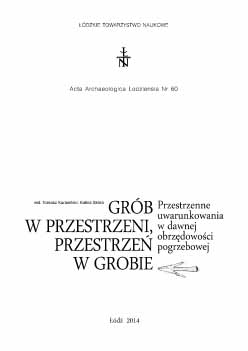Społeczne hierarchie i archeologiczne rankingi grobów. Dyskusja w oparciu o analizy dwóch cmentarzysk z końca epoki brązu w Polsce południowej
Social hierarchies and archeological rankings. Discussion based on the analysis of the two Late Bronze Age cemeteries of Southern Poland
Author(s): Marcin S. PrzybyłaSubject(s): History, Archaeology
Published by: Łódzkie Towarzystwo Naukowe
Keywords: funeral archaeology; Late Bronze Age; social hierarchies
Summary/Abstract: Sources and methods. There are some different methods used by archaeologists in order to establish a ranking of grave assemblages, ordered by their more or less subjectively estimated “richness”. The scope of presented paper is an evaluation of these techniques. For this purpose more then 500 grave inventories were analysed, originating from two large cemeteries dated back to the Late Bronze Age – Early Iron Age transition and located in Southern Poland (Fig. 1). Four absolute methods of scoring (total number of objects made of stone, metal or bone, number of functional categories, “quantity index” – subjective scoring based on the criterion of production cost, approximate weight of metal objects) as well as two relative ones (“splendour index”, “scarcity index”) were subsequently implemented and compared one another. Results. Results obtained by using all techniques are comparable. Correlation indexes counted separately for pairs of different rankings fluctuate usually from 0.8 to 0.9 (Fig. 4-6). It allows us to claim, that in the case of both cemeteries the largest and the most internally diverse grave assemblages, contain also the rarest, the heaviest and the most laborious and material consuming objects. It allows us also to distinguish four separate groups of “richness”, represented on both cemeteries (Fig. 4-5). The “poorest” one is represented by the majority of inventories (about 60%), which may be seen as a “norm” and were equipped with 3-4 vessels of different functional types and sometimes additionally small metal objects (e.g. earrings) as well as burials completely devoided of equipment (about 20-30%). Subsequent analyses showed that number of vessels occurring in grave inventories does not correlate in any way with indexes of their “richness”. However, other interesting correlation is possible to find. Namely, the number and quality of vessels seems to alter among subsequent age categories of deceased (Fig. 9). Particularly, a tendency is observed, that children older then four years are supposed to be equipped often with the whole “adult” set of vessels (cup, bowl, pot and sometimes vase), whilst younger ones got no pottery or only one or two cups. Planigraphy of the sites (Fig. 11-12) showed that burials representing first three groups of “richness” tend to concentrate in small clusters, despite of the facts that they are not restricted to any individual part of the cemeteries.
Journal: Acta Archaeologica Lodziensia
- Issue Year: 2014
- Issue No: 60
- Page Range: 7-28
- Page Count: 22
- Language: Polish

